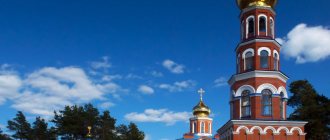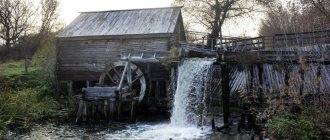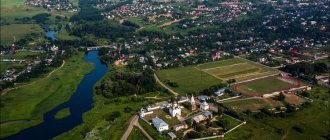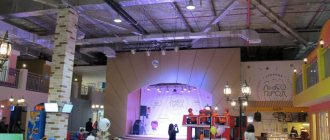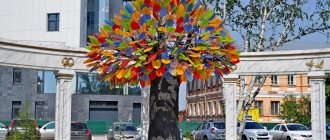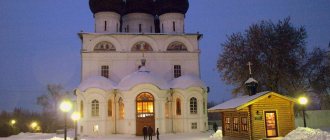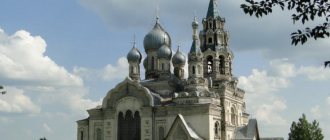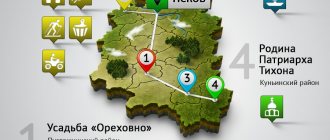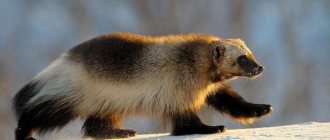Oryol Region
Distance from Kursk - 120 kilometers
In the village of Dolbenkino, on the border of the Kursk and Oryol regions, there is a real Old Russian park. The mill, wooden stove, cart, and hut were made with their own hands by local residents - the Bulychev family. They also organized a local history museum, where you can hear about the history of the village, find out what the royal family did here, hear many stories about the local church and much more.
. . .
City museums
Of the Kursk museums, we first visited the Regional History Museum , located next to the Znamensky Cathedral (Lunacharsky St., 6). This museum is not outstanding. As in any local history museum, there are bones of mammoths and rhinoceroses, stuffed local animals against the backdrop of lovingly recreated corners of nature, and an exhibition telling about the glorious history of the region from primitive people to the present day. I remember one room where items of noble life were collected. The hall itself is beautiful, and the exhibits are good.
A little further, on Pioneer Street, 6, there is the Museum of Archeology . And the building in which the museum is located is interesting (the former chambers of the Romodanovsky boyars, built without a foundation and supported by the thickness of the walls), and the exhibition is memorable.
In a separate hall of the museum, under a separate castle, there is the so-called “gold of the Huns,” a treasure discovered by a “black” digger using a metal detector in 2010. This treasure hunter found treasure at an excavator site and tried to sell it online. But the valiant security officers did not allow this. The treasure hunter was arrested, and the treasure was transferred to the museum. But since, if not for the treasure hunter, the treasure would have disappeared under the excavator bucket, he was not convicted. In general, everything ended well: the treasure hunter is free, the treasures are in the museum, and we can admire them.
The works of ancient jewelers are truly beautiful, and it’s worth going to Kursk just to admire them.
Another very good museum is located quite far from the others - the art gallery named after A. A. Deineka (85 Radishcheva St.). The famous artist is a native of the city. But, unfortunately, we did not see his paintings. But, to our delight, we admired the excellent collection of paintings provided by the Russian Museum. There were paintings by Kuindzhi, Levitan, Myasoedov, Serebryakova and many others. We had great fun.
Levitan
Serebryakova
Clover
Petrov-Vodkin
The art gallery building was disappointing. This is a 2-story brick extension to a typical brick house. You might think that there are so many famous artists in Kursk that there are not enough separate beautiful buildings for their galleries.
In addition to the ones we visited, there are many more museums in Kursk. They say that the Battle of Kursk Museum , located in the building of the House of Officers (this building in itself is outstanding), is interesting.
But we didn’t go there, because we had already seen the interesting museum “Rokossovsky’s dugout” in the village of Svoboda, next to the Root Hermitage.
Bryansk region
Distance from Kursk - 170 kilometers
In the village of Lopandino, on the border of the Oryol, Kursk and Bryansk regions, you can find one of the largest estates in the Black Earth Region. Its owner, a large landowner Maria Voeikova, owned a sugar factory in the Komarichsky district. Voeykova lived 6 kilometers from the plant, in the neighboring village of Radogoshch. It was inconvenient to get there, so the decision was made to build an estate in Lopandino. All this happened at the beginning of the 20th century. The time was approaching revolution. Voeykova, having a presentiment, decided to make the estate strong, high and set up guards in the form of Cossacks. The peasants received little at the factory, and life in the village did not suit them, so they constantly came to her with requests. Maria Vladimirovna fulfilled some of the requests: she raised wages, built new houses for workers, built a school and built a hospital. But the wave of revolution could not be abandoned: the peasants demanded more. By 1917, Voeykova and her family fled to Paris, and her castle passed into Soviet hands. At first there was a school there, then a college, a school, and now the estate is being destroyed and overgrown with grass. And the sugar factory is still operating.
. . .
What to see in Kursk
Kursk is a big city, but modern microdistricts are not of particular interest; they are the same everywhere. A significant part of the city is occupied by streets lined with one or two-story private houses, which is also not very interesting.
The beauty and originality of most Russian cities is given by old buildings, which in Kursk are concentrated in a relatively small area.
Having arrived at the station, we first went to the Root Hermitage, and from there to the city center.
It takes a bus about 20 minutes to get to Red Square from the station, a minibus is faster. The main tourist attractions of Kursk fit into the territory bounded by Sonin, Dzerzhinsky, Alexander Nevsky, Radishchev, Gorky and Sadovaya streets.
Red Square of Kursk is not at all similar to its Moscow namesake, except that it is also large. From Lenin Street there is an entrance, framed by two large buildings with columns, which looks like a cut.
On this square is the House of the Soviets, quite decent in good Soviet style.
Lenin stands in front of him, as expected, with his hand outstretched.
Kursk is located 500 km south of Moscow and is noticeably warmer there. On April 9, when we were there, it was a warm day in Moscow, but in Kursk it was very hot, many were dressed like summer. But Kursk Lenin is doomed, at the whim of the sculptor, to forever be dressed warmly - a coat is thrown over his suit.
Alexander Nevsky stands on the same square. Whatever you want, this monument seemed inexpressive to me.
Belgorod region
Distance from Kursk—120 kilometers
In the village of Alekseevka, Yakovlevsky district, Belgorod region, the house-museum of Mikhail Shchepkin is located. In 1788, when the future actor was born, this village was called Krasny and was part of the Kursk province. Here was the estate of Count Wolkenstein, for whom Misha’s father, Semyon Shchepkin, served as a serf. It was at the Wolkenstein Theater that Shchepkin began his acting career. The museum is open all days from 9-00 to 17-00, except Monday.
. . .
Oryol Region
Distance from Kursk - 120 kilometers
The castle of Vasily Okhotnikov is an unusual building, which is located on the border of the Kursk and Oryol regions in the village of Yakovka. If you have long dreamed of visiting Europe and admiring beautiful architectural structures, this place is especially for you. There was once a sugar factory here, which the landowner built in the 19th century. He traveled a lot in Europe and became imbued with the architecture of those places. There were rumors that in the left tower of the castle, General Okhotnikov held spiritualistic seances and communicated with the souls of his ancestors. The castle is now abandoned.
. . .
Temples of Kursk
The beautiful Znamensky Cathedral also overlooks Red Square, although its address is st. Lunacharskogo, 4.
It was built in 1826 to commemorate the victory over Napoleon. Before the revolution, the cathedral housed the main Kursk shrine - the Root Icon of the Mother of God “The Sign”. After the revolution, the cathedral was looted, but the icon was miraculously found in the well. During the retreat of the White Army, the icon was taken out of the city, and as a result of the ups and downs of emigration, it ended up in New York.
The Council itself also experienced many misfortunes. In 1932 it was closed, then the domes were demolished and a cinema was placed in it. During the retreat, the Germans set fire to the building, which then served as a place to house the same Germans, only prisoners. After the war, the building again housed a cinema. And only in 1992 it was returned to the church.
Now the cathedral has been restored and looks very good both outside and inside.
Directly behind the cathedral is the beautiful Church of the Resurrection . But it is still under restoration and is closed to the public.
There are several more beautiful temples in the city center. We visited the Holy Trinity Convent ,
Resurrection and Elijah Church,
Antonovsky apple and reflection of the Resurrection-Ilyinsky Church
Sergius-Kazan Cathedral.
All of them are good in their own way and worth a visit. There are many interesting churches in other areas of Kursk.
Trinity Church
Vvedenskaya Church
A little away from the center, but also within walking distance, on Marata Street, there is a Roman Catholic church . It is now operational and its renovation is almost complete. This church is famous for the fact that the author of the famous “Black Square”, Kazimir Malevich, was married there, as indicated by the memorial plaque mounted at the entrance.
Voronezh region
Distance from Kursk - 190 kilometers
The longest suspension bridge in the Black Earth Region is located in the village of Strelitsa. Its length is 300 meters. There is also an ideal place for a weekend nearby. The white well is mountains, sand, lake. Might make a good weekend itinerary.
. . .
Bryansk region
Distance from Kursk - 190 kilometers
The fortress of the 17th-18th centuries is located in the Sevsky district of the Bryansk region. Inside the fortress there is the Spaso-Preobrazhensky Monastery, which was built at a time when the route from Moscow to Kyiv passed through these lands. Outside are walls and towers, and inside are the ruins of the monastery itself. The city of Sevsk also deserves attention. Nice, old.
. . .
Recreation centers of the Kursk region
Kursk and the region are an educational and interesting place for travel lovers. Despite the fact that this place is a deep province, it is located only five hundred kilometers from Moscow. This region is fraught with ancient history; it is a stronghold of Russian statehood.
This area is famous for its picturesque places and natural resources that can surprise anyone. And many historical and cultural monuments will expand the horizons and erudition of people who visit this wonderful place. It is a fact that many tourists who once came to this area returned here more than once and left with new, vivid impressions. Therefore, while traveling around the Russian Federation, it is worth visiting this region and enjoying its amazing history.
Since religion occupies one of the most important places in the development of the region, pilgrimage is a common area of tourism here. That is why most tourist centers offer trips to the holy places of the region. The most common:
- Church of the Nativity of the Blessed Virgin Mary (restored),
- Monastery "Root Hermitage".
By the way, this place is a shrine to the southern region of our vast homeland. In this place there is a famous icon, which the monastery workers have the honor of carrying out during religious processions. This is a very important event in the life of both local and visiting Christians.
In addition to these two places, in the Kursk region there are many churches, monasteries and temples that will be happy to welcome any visiting guests of the region.
Excursions to religious places strengthen a person’s faith, his morale, make a person kinder, stronger, and more resistant to life’s troubles. That's why it's so beneficial to visit such places.
Kursk and the region are a very ancient land, initially and to this day, it belonged to Russia, therefore it has preserved the history of not only its region, but also the entire country as a whole. It is important that this area was first mentioned in chronicles in the eleventh century. It was then that battles with the Polovtsians took place in Rus'. Therefore, Kursk was mentioned in various literary works. The most famous of them is “The Tale of Igor’s Campaign.”
After this, the region constantly changed rulers and belonged to various principalities. This lasted until the city became part of the Principality of Moscow and became its southern border. In the 16th century, Kursk was surrounded by a fortress named after the city. The remains of this fortress have survived to this day.
These lands keep great memories of the harsh battles that took place there. The fiercest battles in the seventeenth century, when the Polish-Lithuanian people wanted to conquer our country, the Battle of Borodino - one of the most famous in the war of 1812, the Battle of Poltava, turbulent times during the Civil War and Revolution - all the hardships of these years were endured by the brave soldiers of Kursk. And now, in places of bloody battles, monuments have been erected in order to honor the memory of the soldiers who defended their Motherland at the cost of their own lives. Many tourists come to these places, excursions are organized, where talented guides talk about the details of the battles, about what our ancestors had to endure in order to defend the country.
The region is also famous for its healing mud and mineral waters. These natural resources can be enjoyed in sanatoriums and boarding houses that provide special treatment services to their guests. The famous waters are Khalinsky (sodium chloride), Zhuravlinsky (hydrocarbonate), Mirgorod.
As for mud, there are several most popular types: mud from the Korenevsky district, mud from Pushkaro-Zhadinsk, Palanga, Dorokhovo. These muds can cure chronic diseases, but they are also used to improve overall health.
It is important to know that in addition to sanatoriums and boarding houses, there are a lot of various tourist centers and holiday homes that will warmly welcome any guests. And the service close to the European level will delight the guests.
Kursk land has reservoirs rich in fish. Therefore, this place will appeal to fishermen. Indeed, in some reservoirs there are more than 30 species of fish. The Seim, Svapa and Psel rivers are full of pike perch, burbot, pike, bream, asp, chub, grass carp, carp, catfish and ide. Tourists can also enjoy the picturesque nature and fresh air.
And the Kursk forests are home to many animals. Hunting for them is organized by camp sites, in accordance with the laws of the Russian Federation.
In conclusion, I would like to say that the Kursk region is a real paradise for travel. Here everyone can find something interesting for themselves. Holidays in pristine nature, a huge selection of excursions and various entertainments will not leave anyone indifferent. And hospitable local boarding houses, hostels, tourist centers and sanatoriums will take care of your comfortable stay in this wonderful area.
